Quasi-1D NbTe4 for Broadband Pulse Generation from 1.0 to 3.0 μm: Bridging the Near- and Mid-Infrared
Abstract
1. Introduction
2. Materials and Methods
2.1. Synthesis of NbTe4 Powder
2.2. Preparation of NbTe4 Nanosheets and NbTe4-Based Saturable Absorber
2.3. Nonlinear Optical Response of NbTe4-Based Saturable Absorber
2.4. Laser Application of NbTe4-SA in Broadband Absorption
3. Results and Discussion
3.1. Characterization of NbTe4 Nanosheets
3.2. Performance Characterization of Passively Q-Switched Lasers at 1.0 μm and 2.0 μm
3.3. Performance Characterization of Mode-Locked Lasers at 3.0 μm
4. Conclusions
Author Contributions
Funding
Data Availability Statement
Conflicts of Interest
Abbreviations
| quasi-1D | Quasi one dimensional |
| 2D | Two dimensional |
| TMCs | Transition metal chalcogenides |
| SA | Saturable absorber |
| PQS | Passively Q-switched |
| NLO | Nonlinear optical |
| vdW | van der Waals |
| CDWs | Charge density waves |
| SC | Superconductivity |
| SWCNTs | Single-walled carbon nanotubes |
| TMTCs | Transition metal trichalcogenides |
| LPE | Liquid-phase exfoliation |
| XRD | X-ray diffraction |
| EDS | Energy dispersive X-ray spectroscopy |
| AFM | Atomic force microscopy |
| TEM | Transmission electron microscopy |
| HRTEM | High-resolution transmission electron microscopy |
| IPA | Isopropyl alcohol |
| OA | Open aperture |
| OC | Output coupler |
| NA | Numerical aperture |
| RMSD | Root-mean-square deviation |
| FWHM | Full width at half maximum |
| RF | Radio frequency |
| SNR | Signal-to-noise ratio |
| CW | Continuous wave |
| QML | Q-switched mode-locked |
| CWML | Continuous-wave mode-locking |
Appendix A
Appendix A.1

Appendix A.2

Appendix B
Appendix B.1. P-Scan Experimental Setup
Appendix B.2. 2.0 μm Laser Experimental Setup
Appendix B.3. Measurement Instruments for 1.0 μm and 2.0 μm PQS Laser Characterization
Appendix B.4. Measurement Setup for 3.0 μm Mode-Locked Fiber Laser Characterization
References
- Zhu, G.; Zhu, X.; Wang, F.; Xu, S.; Li, Y.; Guo, X.; Balakrishnan, K.; Norwood, R.; Peyghambarian, N. Graphene Mode-Locked Fiber Laser at 2.8 μm. IEEE Photonics Technol. Lett. 2016, 28, 7–10. [Google Scholar] [CrossRef]
- Zhang, R.; Zhang, Y.; Yu, H.; Zhang, H.; Yang, R.; Yang, B.; Liu, Z.; Wang, J. Broadband Black Phosphorus Optical Modulator in the Spectral Range from Visible to Mid-Infrared. Adv. Opt. Mater. 2015, 3, 1787–1792. [Google Scholar] [CrossRef]
- Pan, Y.; Jia, K.; Xiong, Y.; Pan, H.; Cheng, S.; Gao, S. 1.45 Ps All-Solid-State Q-Switched Mode-Locked Laser Based on New Material Bi2Te3/Sb2Te3. Opt. Laser Technol. 2025, 182, 112228. [Google Scholar] [CrossRef]
- Liu, D.; He, C.; Chen, L.; Li, W.; Zu, Y. The Nonlinear Absorption Effects and Optical Limiting Properties of Bi2Te3/rGO Thin Films. Opt. Mater. 2021, 111, 110634. [Google Scholar] [CrossRef]
- Ma, X.; Chen, W.; Tong, L.; Liu, S.; Dai, W.; Ye, S.; Zheng, Z.; Wang, Y.; Zhou, Y.; Zhang, W.; et al. In2S3-Based Saturable Absorber for Passively Harmonic Mode-Locking in 2 μm Region. Opt. Laser Technol. 2022, 145, 107476. [Google Scholar] [CrossRef]
- Chen, B.; Zhang, X.; Wu, K.; Wang, H.; Wang, J.; Chen, J. Q-Switched Fiber Laser Based on Transition Metal Dichalcogenides MoS2, MoSe2, WS2, and WSe2. Opt. Express 2015, 23, 26723–26737. [Google Scholar] [CrossRef] [PubMed]
- Mohanraj, J.; Velmurugan, V.; Sivabalan, S. Transition Metal Dichalcogenides Based Saturable Absorbers for Pulsed Laser Technology. Opt. Mater. 2016, 60, 601–617. [Google Scholar] [CrossRef]
- Ma, P.; Lin, W.; Zhang, H.; Xu, S.; Yang, Z. High-Power Large-Energy Raman Soliton Generations Within a Mode-Locked Yb-Doped Fiber Laser Based on High-Damage-Threshold CVD-MoS2 as Modulator. Nanomaterials 2019, 9, 1305. [Google Scholar] [CrossRef]
- Dong, X.; Li, Z.; Pang, C.; Dong, N.; Jiang, H.; Wang, J.; Chen, F. Q-Switched Mode-Locked Nd:GGG Waveguide Laser with Tin Disulfide as Saturable Absorber. Opt. Mater. 2020, 100, 109702. [Google Scholar] [CrossRef]
- Liu, J.; Li, X.; Guo, Y.; Qyyum, A.; Shi, Z.; Feng, T.; Zhang, Y.; Jiang, C.; Liu, X. SnSe2 Nanosheets for Subpicosecond Harmonic Mode-Locked Pulse Generation. Small 2019, 15, 1902811. [Google Scholar] [CrossRef]
- Jiang, X.; Liu, S.; Liang, W.; Luo, S.; He, Z.; Ge, Y.; Wang, H.; Cao, R.; Zhang, F.; Wen, Q.; et al. Broadband Nonlinear Photonics in Few-Layer MXene Ti3C2Tx (T = F, O, or OH). Laser Photonics Rev. 2018, 12, 1700229. [Google Scholar] [CrossRef]
- Jhon, Y.; Koo, J.; Anasori, B.; Seo, M.; Lee, J.; Gogotsi, Y.; Jhon, Y. Metallic MXene Saturable Absorber for Femtosecond Mode-Locked Lasers. Adv. Mater. 2017, 29, 1702496. [Google Scholar] [CrossRef]
- Xia, X.; Ma, C.; Chen, H.; Khan, K.; Tateen, A.; Xiao, Q. Nonlinear Optical Properties and Ultrafast Photonics of 2D BP/Ti3C2 Heterostructures. Opt. Mater. 2021, 112, 110809. [Google Scholar] [CrossRef]
- Su, C.; Liu, Y.; Feng, T.; Qiao, W.; Zhao, Y.; Liang, Y.; Li, T. Optical Modulation of the MXene Ti3C2Tx Saturable Absorber for Er: Lu2O3 Laser. Opt. Mater. 2021, 115, 110949. [Google Scholar] [CrossRef]
- Chen, M.; Li, L.; Xu, M.; Li, W.; Zheng, L.; Wang, X. Quasi-One-Dimensional van Der Waals Transition Metal Trichalcogenides. Research 2023, 6, 0066. [Google Scholar] [CrossRef] [PubMed]
- Ortega-Mendoza, J.; Kuzin, E.; Zaca-Morán, P.; Chávez, F.; Gómez-Pavón, L.; Padilla-Vivanco, A.; Toxqui-Quitl, C.; Luis-Ramos, A. Photodeposition of SWCNTs onto the Optical Fiber End to Assemble a Q-Switched Er3+-Doped Fiber Laser. Opt. Laser Technol. 2017, 91, 32–35. [Google Scholar] [CrossRef]
- Shah, U.; Chen, S.; Khalaf, G.; Jin, Z.; Song, H. Wide Bandgap Sb2S3 Solar Cells. Adv. Funct. Mater. 2021, 31, 2100265. [Google Scholar] [CrossRef]
- Chen, X.; Zhang, B.; Zhang, F.; Wang, Y.; Zhang, M.; Yang, Z.; Poeppelmeier, K.; Pan, S. Designing an Excellent Deep-Ultraviolet Birefringent Material for Light Polarization. J. Am. Chem. Soc. 2018, 140, 16311–16319. [Google Scholar] [CrossRef]
- Chen, F.; Liu, G.; Xiao, Z.; Zhou, H.; Fei, L.; Wan, S.; Liao, X.; Yuan, J.; Zhou, Y. Quasi-One-Dimensional ZrS3 Nanoflakes for Broadband and Polarized Photodetection with High Tuning Flexibility. ACS Appl. Mater. Interfaces 2023, 15, 16999–17008. [Google Scholar] [CrossRef]
- Sokolov, M.; Fedin, V. Chalcogenide Clusters of Vanadium, Niobium and Tantalum. Coord. Chem. Rev. 2004, 248, 925–944. [Google Scholar] [CrossRef]
- Wang, Y.; Liu, Z.; Wang, C.; Yi, X.; Chen, R.; Ma, L.; Hu, Y.; Zhu, G.; Chen, T.; Tie, Z.; et al. Highly Branched VS4 Nanodendrites with 1D Atomic-Chain Structure as a Promising Cathode Material for Long-Cycling Magnesium Batteries. Adv. Mater. 2018, 30, 1802563. [Google Scholar] [CrossRef]
- Luo, L.; Li, J.; Asl, H.; Manthiram, A. In-Situ Assembled VS4 as a Polysulfide Mediator for High-Loading Lithium-Sulfur Batteries. ACS Energy Lett. 2020, 5, 1177–1185. [Google Scholar] [CrossRef]
- Xing, L.; Owusu, K.; Liu, X.; Meng, J.; Wang, K.; An, Q.; Mai, L. Insights into the Storage Mechanism of VS4 Nanowire Clusters in Aluminum-Ion Battery. Nano Energy 2021, 79, 105384. [Google Scholar] [CrossRef]
- Zwick, F.; Berger, H.; Grioni, M.; Margaritondo, G.; Forró, L.; LaVeigne, J.; Tanner, D.; Onellion, M. Coexisting One-Dimensional and Three-Dimensional Spectral Signatures in TaTe4. Phys. Rev. B 1999, 59, 7762–7766. [Google Scholar] [CrossRef]
- Yuan, Y.; Wang, W.; Zhou, Y.; Chen, X.; Cu, C.; An, C.; Zhou, Y.; Zhang, B.; Chen, C.; Zhang, R.; et al. Pressure-Induced Superconductivity in Topological Semimetal Candidate TaTe4. Adv. Electron. Mater. 2020, 6, 1901260. [Google Scholar] [CrossRef]
- Shuang, Y.; Chen, Q.; Kim, M.; Wang, Y.; Saito, Y.; Hatayama, S.; Fons, P.; Ando, D.; Kubo, M.; Sutou, Y. NbTe4 Phase-Change Material: Breaking the Phase-Change Temperature Balance in 2D Van Der Waals Transition-Metal Binary Chalcogenide. Adv. Mater. 2023, 35, 2303646. [Google Scholar] [CrossRef] [PubMed]
- de Lima, B.; Chaia, N.; Grant, T.; de Faria, L.; Canova, J.; de Oliveira, F.; Abud, F.; Machado, A. Large Enhancement of the CDW Resistivity Anomaly and Traces of Superconductivity in Imperfect Samples of NbTe4. Mater. Chem. Phys. 2019, 226, 95–99. [Google Scholar] [CrossRef]
- Sheik-Bahae, M.; Said, A.A.; Wei, T.H.; Hagan, D.J.; Van Stryland, E.W. Van Stryland Sensitive Measurement of Optical Nonlinearities Using a Single Beam. IEEE J. Quantum Electron. 1990, 26, 760–769. [Google Scholar] [CrossRef]
- Zhu, C.; Wang, F.; Meng, Y.; Yuan, X.; Xiu, F.; Luo, H.; Wang, Y.; Li, J.; Lv, X.; He, L.; et al. A Robust and Tuneable Mid-Infrared Optical Switch Enabled by Bulk Dirac Fermions. Nat. Commun. 2017, 8, 14111. [Google Scholar] [CrossRef]
- Chu, Z.; Liu, J.; Guo, Z.; Zhang, H. 2 μm Passively Q-Switched Laser Based on Black Phosphorus. Opt. Mater. Express 2016, 6, 2374–2379. [Google Scholar] [CrossRef]
- Qin, Z.; Xie, G.; Zhao, C.; Wen, S.; Yuan, P.; Qian, L. Mid-Infrared Mode-Locked Pulse Generation with Multilayer Black Phosphorus as Saturable Absorber. Opt. Lett. 2016, 41, 56–59. [Google Scholar] [CrossRef] [PubMed]
- Wang, S.; Yu, H.; Zhang, H.; Wang, A.; Zhao, M.; Chen, Y.; Mei, L.; Wang, J. Broadband Few-Layer MoS2 Saturable Absorbers. Adv. Mater. 2014, 26, 3538–3544. [Google Scholar] [CrossRef]
- Ge, P.; Liu, J.; Jiang, S.; Xu, Y.; Man, B. Compact Q-Switched 2 μm Tm:GdVO4 Laser with MoS2 Absorber. Photonics Res. 2015, 3, 256–259. [Google Scholar] [CrossRef]
- Wang, S.; Tang, Y.; Yang, J.; Zhong, H.; Fan, D. MoS2 Q-Switched 2.8 μm Er:ZBLAN Fiber Laser. Laser Phys. 2019, 29, 025101. [Google Scholar] [CrossRef]
- Zhang, W.; Liang, Y.; Gan, Y.; Huang, H.; Liang, G.; Kang, Q.; Leng, X.; Jing, Q.; Wen, Q. VTe2: Broadband Saturable Absorber for Passively Q-Switched Lasers in the Near- and Mid-Infrared Regions. ACS Appl. Mater. Interfaces 2023, 15, 57475–57485. [Google Scholar] [CrossRef] [PubMed]
- Lin, H.; Liu, X.; Huang, X.; Xu, Y.; Meng, X.; Xiong, F. Monolayer Graphene-Based Passively Q-Switched Nd:YAG Laser. Optik 2016, 127, 243–245. [Google Scholar] [CrossRef]
- Wang, Q.; Teng, H.; Zou, Y.; Zhang, Z.; Li, D.; Wang, R.; Gao, C.; Lin, J.; Guo, L.; Wei, Z. Graphene on SiC as a Q-Switcher for a 2 μm Laser. Opt. Lett. 2012, 37, 395–397. [Google Scholar] [CrossRef]
- Li, P.; Zhang, G.; Zhang, H.; Zhao, C.; Chi, J.; Zhao, Z.; Yang, C.; Hu, H.; Yao, Y. Q-Switched Mode-Locked Nd:YVO4 Laser by Topological Insulator Bi2Te3 Saturable Absorber. IEEE Photonics Technol. Lett. 2014, 26, 1912–1915. [Google Scholar] [CrossRef]
- Gao, P.; Huang, H.; Wang, X.; Liu, H.; Huang, J.; Weng, W.; Dai, S.; Li, J.; Lin, W. Passively Q-Switched Solid-State Tm:YAG Laser Using Topological Insulator Bi2Te3 as a Saturable Absorber. Appl. Opt. 2018, 57, 2020–2024. [Google Scholar] [CrossRef]
- Yin, K.; Jiang, T.; Zheng, X.; Yu, H.; Cheng, X.; Hou, J. Mid-Infrared Ultra-Short Mode-Locked Fiber Laser Utilizing Topological Insulator Bi2Te3 Nano-Sheets as the Saturable Absorber. arXiv 2015, arXiv:1505.06322. [Google Scholar]
- Zhang, W.; Huang, H.; Wang, Z.; Kang, Q.; Liu, S.; Lu, S.; Wen, Q. Ternary Chalcogenide Ta2NiTe5 as Broadband Saturable Absorber for Passively Q-Switched Pulse Generation. Adv. Opt. Mater. 2024, 12, 2301261. [Google Scholar] [CrossRef]
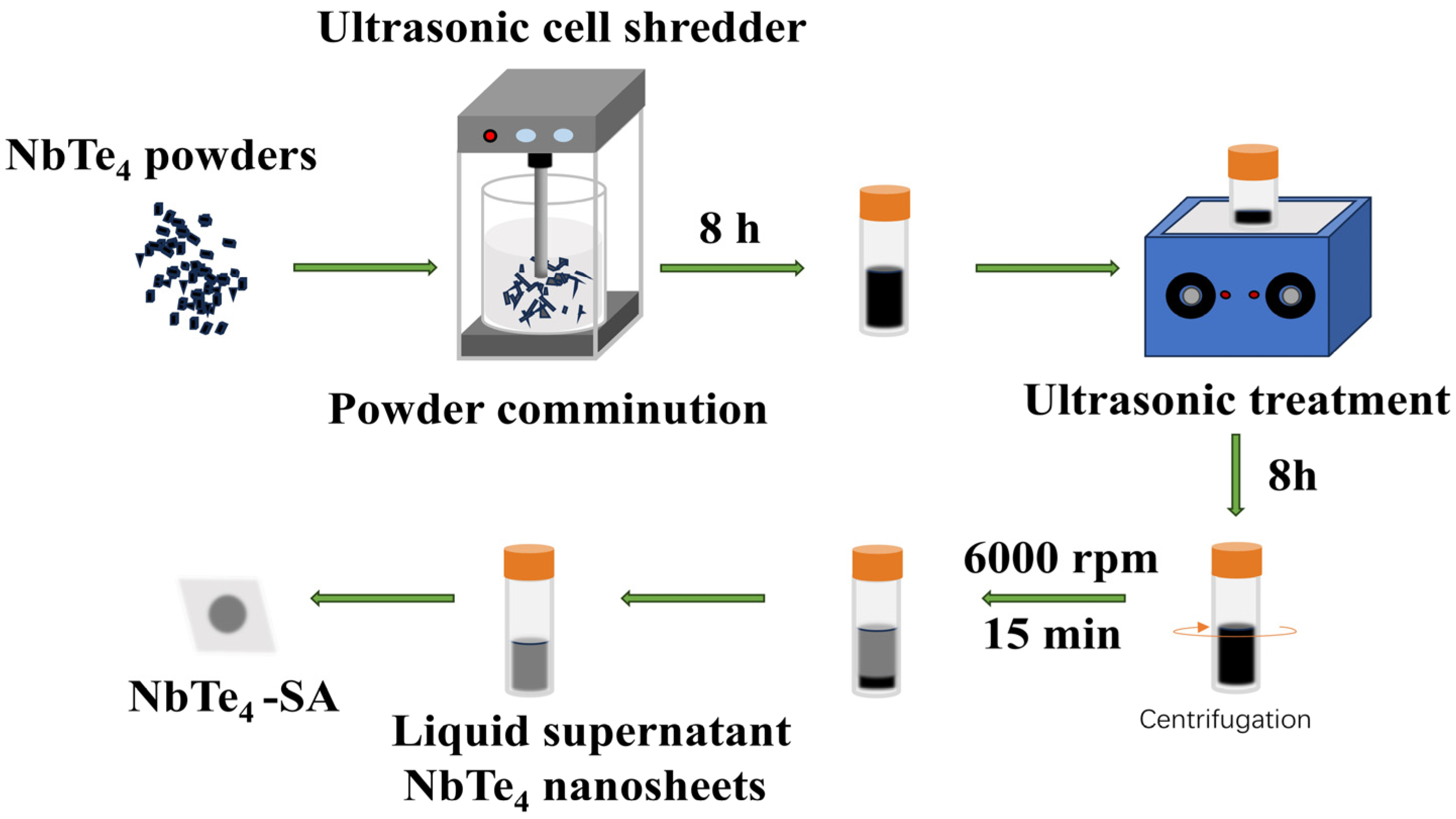
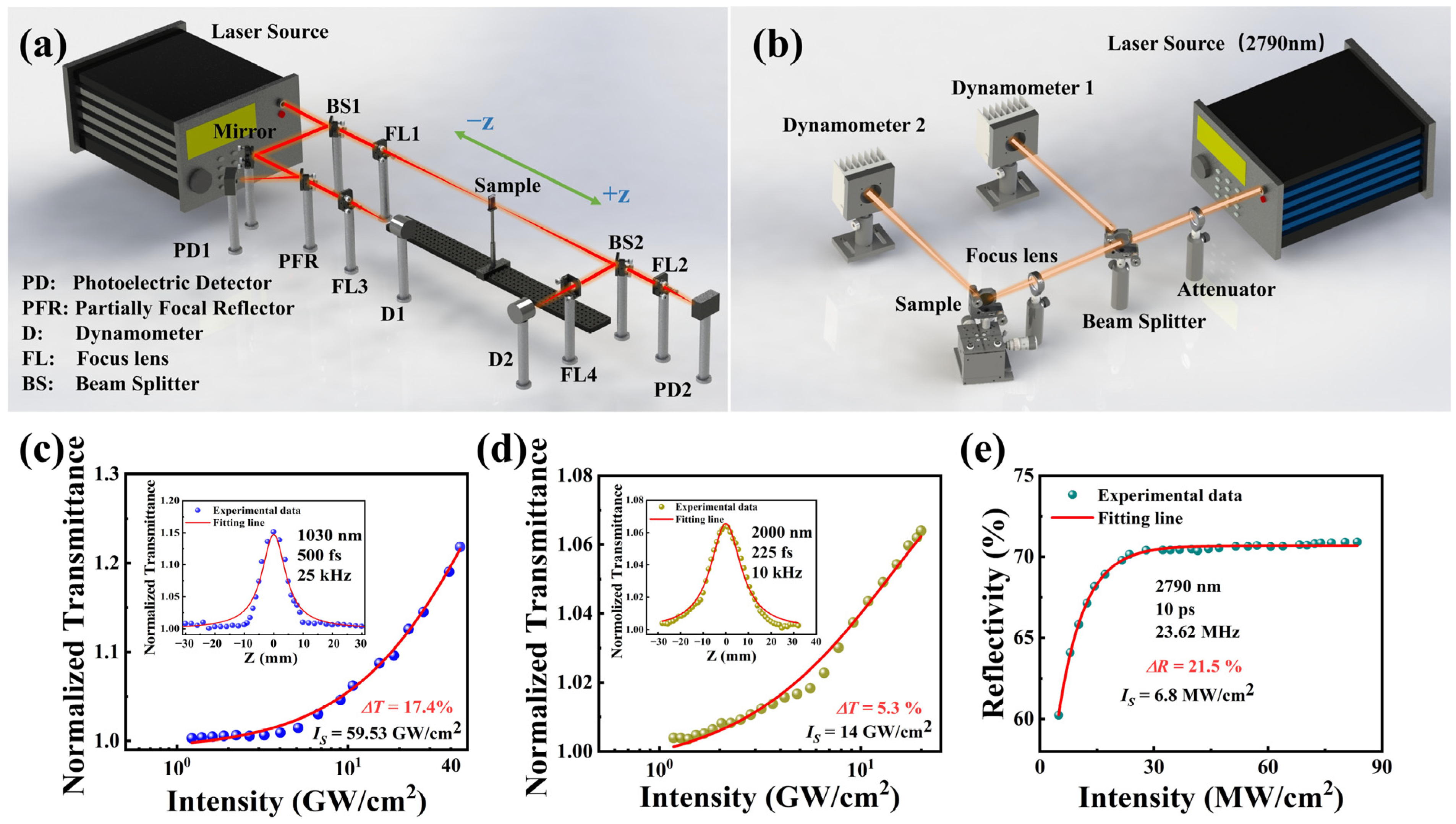

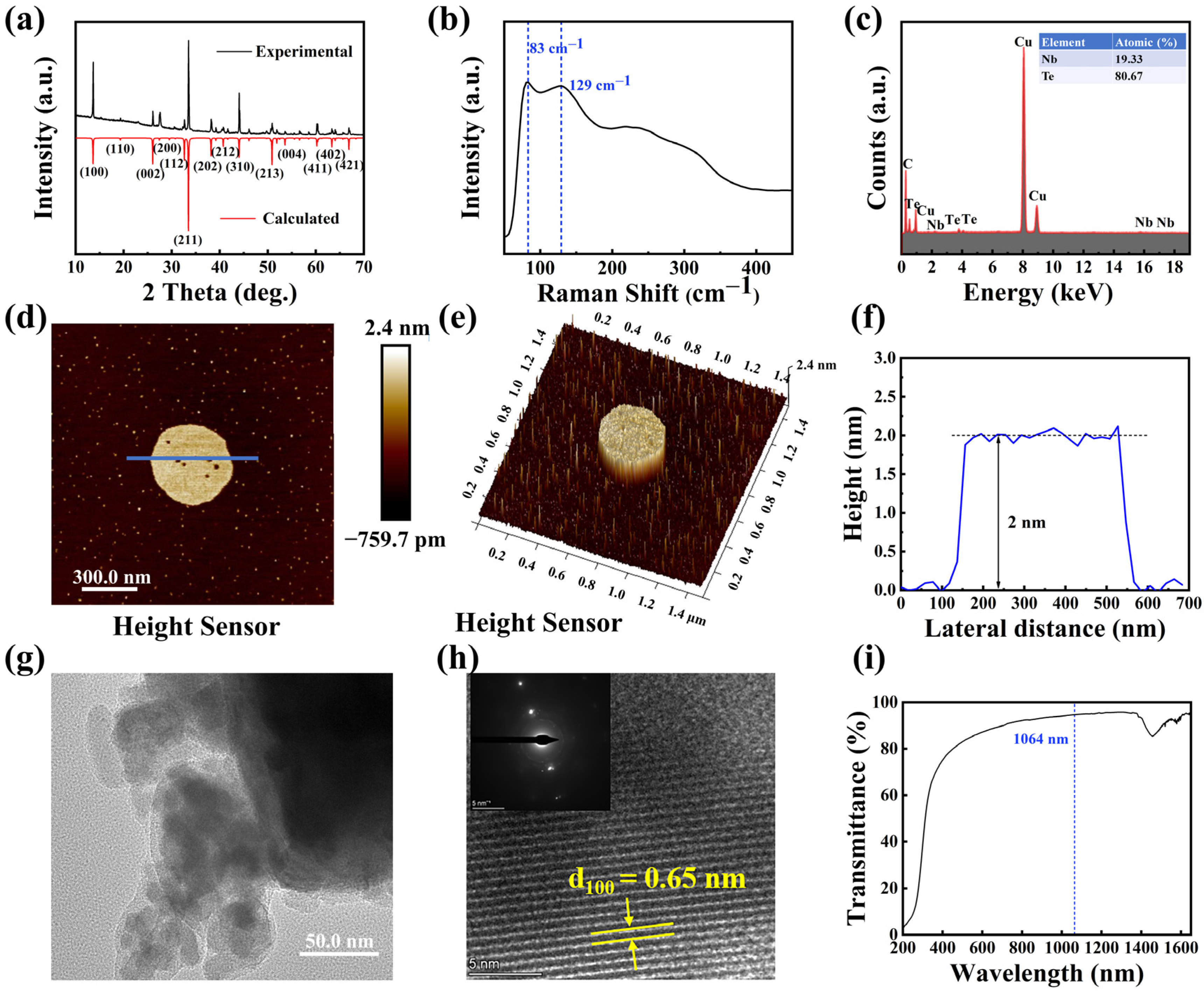
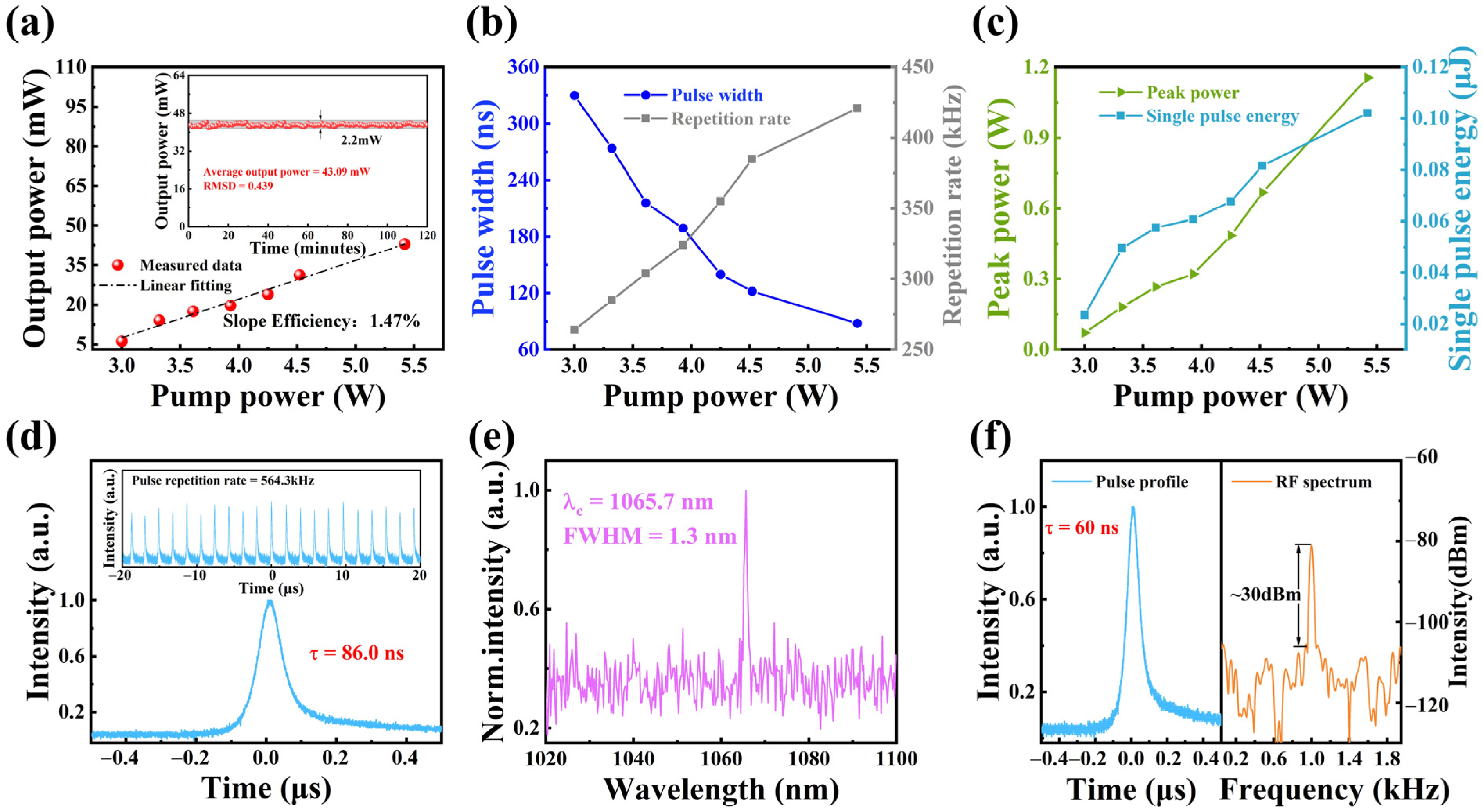
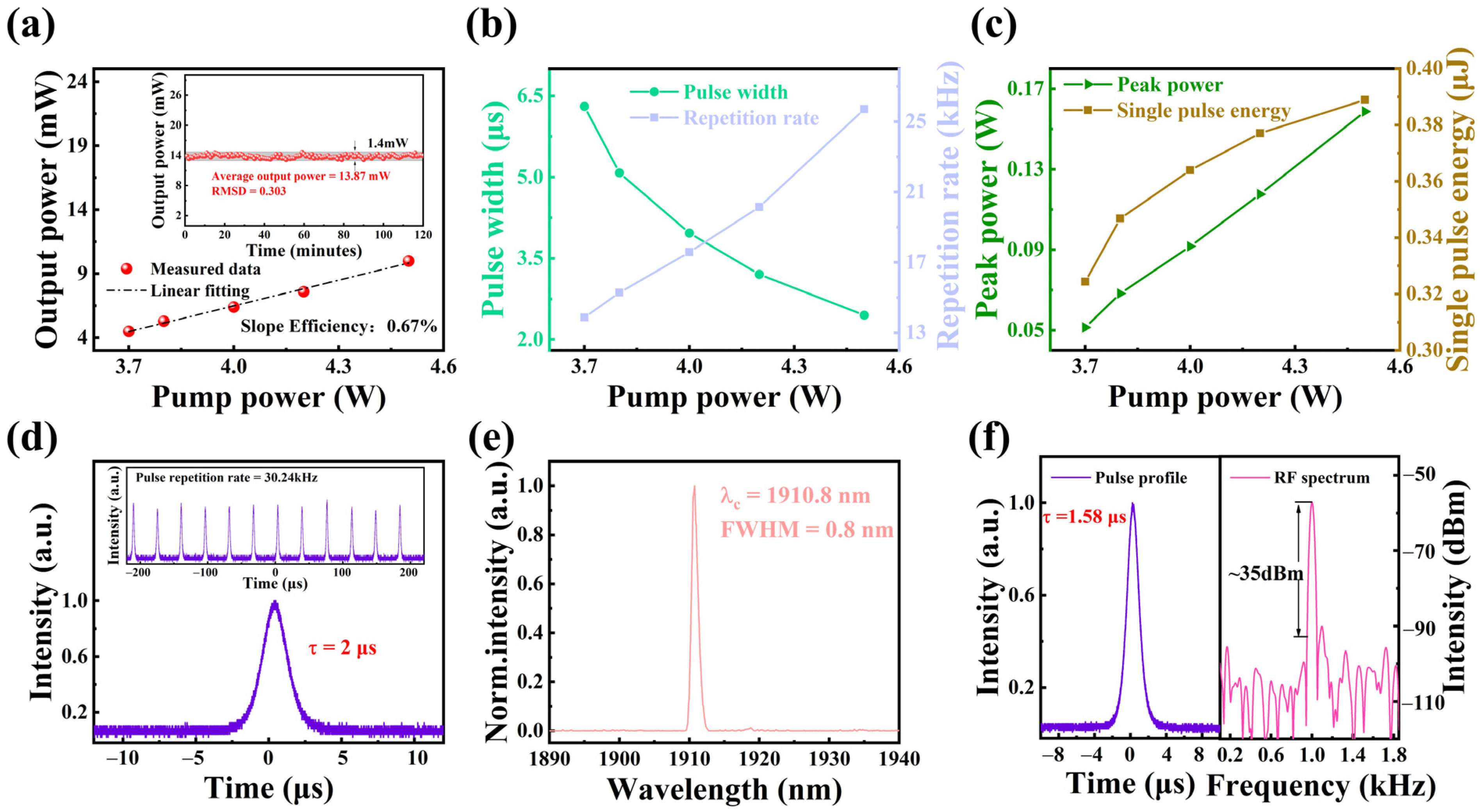

| SA | λ (μm) | Operation Mode | Pulse Width (ns) | Output Power (mW) | Repetition Rate (kHz) | Single Pulse Energy (μJ) | Peak Power (W) | Ref. |
|---|---|---|---|---|---|---|---|---|
| BP | 1.0 | PQS | 495 | 22 | 312 | 0.07 | 0.14 | [2] |
| 2.0 | PQS | 1780 | 151 | 19.25 | 7.84 | 4.4 | [30] | |
| 3.0 | CWML | 0.042 | 613 | 24,270 | 0.0255 | 607 | [31] | |
| MoS2 | 1.0 | PQS | 970 | 227 | 732 | 0.31 | 0.32 | [32] |
| 2.0 | PQS | 800 | 100 | 48.09 | 2.08 | 2.6 | [33] | |
| 3.0 | PQS | 806 | 140 | 70 | 2 | 2.48 | [34] | |
| VTe2 | 1.0 | PQS | 195 | 88 | 350 | 0.25 | 1.29 | [35] |
| 2.0 | PQS | 563 | 237 | 62.5 | 3.79 | 6.73 | ||
| 3.0 | PQS | 749 | 402.8 | 129.8 | 3.1 | 4.14 | ||
| Graphene | 1.0 | PQS | 753 | 266 | 436 | 0.61 | 0.81 | [36] |
| 2.0 | PQS | 2080 | 38 | 18.1 | 1.74 | 0.84 | [37] | |
| 3.0 | CWML | 0.042 | 18 | 25,400 | 0.0007 | 16.87 | [1] | |
| Bi2Te3 | 1.0 | PQS | 2000 | 183 | 151.5 | 1.21 | 0.6 | [38] |
| 2.0 | PQS | 382 | 272 | 57.67 | 4.8 | 12 | [39] | |
| 3.0 | CWML | 0.021 | 360 | 42,430 | 0.008 | 400 | [40] | |
| Ta2NiTe5 | 1.0 | PQS | 330 | 273 | 192 | 1.42 | 4.36 | [41] |
| 2.0 | PQS | 2600 | 780 | 22 | 35.1 | 13.5 | ||
| 3.0 | PQS | 850 | 182 | 125 | 1.46 | 1.71 | ||
| NbTe4 | 1.0 | PQS | 86 | 43.09 | 420.6 | 0.1 | 1.15 | This work |
| 2.0 | PQS | 2000 | 13.87 | 25.7 | 0.388 | 0.16 | ||
| 3.0 | CWML | 0.019 | 257 | 23,620 | 0.011 | 570 |
Disclaimer/Publisher’s Note: The statements, opinions and data contained in all publications are solely those of the individual author(s) and contributor(s) and not of MDPI and/or the editor(s). MDPI and/or the editor(s) disclaim responsibility for any injury to people or property resulting from any ideas, methods, instructions or products referred to in the content. |
© 2025 by the authors. Licensee MDPI, Basel, Switzerland. This article is an open access article distributed under the terms and conditions of the Creative Commons Attribution (CC BY) license (https://creativecommons.org/licenses/by/4.0/).
Share and Cite
Cai, Z.; Zhang, W.; Kang, Q.; Huang, H.; Xiang, X.; Lu, S.; Wen, Q. Quasi-1D NbTe4 for Broadband Pulse Generation from 1.0 to 3.0 μm: Bridging the Near- and Mid-Infrared. Nanomaterials 2025, 15, 424. https://doi.org/10.3390/nano15060424
Cai Z, Zhang W, Kang Q, Huang H, Xiang X, Lu S, Wen Q. Quasi-1D NbTe4 for Broadband Pulse Generation from 1.0 to 3.0 μm: Bridging the Near- and Mid-Infrared. Nanomaterials. 2025; 15(6):424. https://doi.org/10.3390/nano15060424
Chicago/Turabian StyleCai, Zian, Wenyao Zhang, Qi Kang, Hongfu Huang, Xin Xiang, Shunbin Lu, and Qiao Wen. 2025. "Quasi-1D NbTe4 for Broadband Pulse Generation from 1.0 to 3.0 μm: Bridging the Near- and Mid-Infrared" Nanomaterials 15, no. 6: 424. https://doi.org/10.3390/nano15060424
APA StyleCai, Z., Zhang, W., Kang, Q., Huang, H., Xiang, X., Lu, S., & Wen, Q. (2025). Quasi-1D NbTe4 for Broadband Pulse Generation from 1.0 to 3.0 μm: Bridging the Near- and Mid-Infrared. Nanomaterials, 15(6), 424. https://doi.org/10.3390/nano15060424






